Burson V6 Classic Opamp Review – Carnegie Hall
In this Article
Executive Summary
The Burson V6 Classic opamps are a valid alternative to the V6 Vivid opamps for those who prefer a leaner, wider, and better resolving sound. The V6 Classic work particularly well with acoustic pieces and jazz, but also with sources too warm for the V6 Vivid.
Introduction
Burson Audio is a >20-year old innovative company from Australia that produce high-quality DACs and amps. They started their business with opamps and other audio parts before dipping into complete devices.
I have exhaustively analyzed their lowest-priced amp, the Burson Funk, which, in its “Deluxe Package”, comes with a pair of Burson’s flagship V6 Vivid opamps that produce an energetic and dynamic sound. But the company offers another set of flagship opamps separately, the V6 Classic, which generate an alternative sound signature.
Both V6 Classic and V6 Vivid retailed at $85 per piece/$145 per pair at the time of this review. You can order them from Burson. Both models are based on 12 years of research and carry a life-long warranty. V6 stands for Version 6 (or 6th generation). You can learn about their internals here.
What are Opamps?
Operational amps (“opamps”) are one of the building blocks of analog electronics circuits, used for sound optimization and customization. Opamps fine tune the’s sonic signature and help tailor the sound to the listener’s preference – similar to tubes in tube amps.
Opamps are universally deployable across different amps independent of brand. They are easily plugged into/pulled out of an amp’s logic board.
Caution, “opamp rolling” can be addictive!
Physicals and Installation
In the box are two opamps and two adapters. You don’t need the adapters when plugging the opamps into a Burson amp. If using them with amps of other brands, make sure there is enough space in the enclosure. Considering that most other opamps are these flat spider-like things, the Burson opamps are little skyscrapers.

You install the opamps by opening the enclosure (Allen keys included), align them according to manual, and stick them into the dedicated slots on the logic board. The Burson Funk, for example, has 2 such slots, one for speakers, and the other for headphones.
And if you align the opamps incorrectly, Burson’s unique “reverse voltage protection” prevents them from getting damaged.

The Burson Funk holds two opamps, one for the headphone circuit and the other for the speaker circuit. You can use a different opamp in each signal path. Many users prefer the V6 Classic for headphone use and the V6 Vivid for speakers.


Test Setup
I tested both opamp models, the V6 Classic and the V6 Vivid with the Burson Funk and different headphones/earphones. I used a neutral and a warm source to establish a possible source dependence for the performance of these opamps. After all, you’d expect the warm V6 Classic to pair better with a neutral source and the V6 Vivid to harmonize best with a warm source.
Neutral source setup: Questyle QP1R as DAC via AudioQuest Golden Gate RCA interconnects into Burson Funk amp. Warm source setup: Questyle QP1R as transport via Lifatec USA optical cable into EarMen Tradutto DAC and via AudioQuest Golden Gate RCA interconnects into Burson Funk amp; Sennheiser HD 600 headphones, JVC HA-FDX1 and Final E5000 iems.
Sound
Previously, I had tested the V6 Vivid opamps for my exhaustive Burson Funk review. What became evident to me was how the Burson Funk with the V6 Vivid opamps replaces the neutral signature of the Questyle’s own Class A amp with a slight warmth and an overall subtle tone colour. Sound is quite natural and definitely not digitally artificial.
Replacing the Vivid with the V6 Classic changes the Funk’s sound substantially — similar to exchanging the pickup of a record player or the eartips on an iem.
To give you the helicopter view: the Classic make the Funk’s sound sound wider, more open, leaner, more neutral, and flatter, but also faster. In contrast, the V6 Vivid create a thicker, bassier/warmer, deeper, more dynamic but also narrower sound.
In detail, the V6 Classic deliver a tighter, faster, more composed bass compared to the V6 Vivid’s thicker, richer, and warmer low end with a better sub-bass extension, which contributes to the V6 Vivid’s deeper soundstage. On the other hand, the V6 Classic’s more forward treble makes for a wider, more open but also flatter stage. Due to the lesser warmth from the bass, the V6 Classic’s mids are leaner, cleaner, and clearer, as opposed to the Vivid’s richer, smoother, softer, and more rounded notes. This results in a better midrange resolution, transparency, and spatial cues in the V6 Classic.
Saxophones, cellos, and vocals sound leaner and “sharper” with the V6 Classic and smoother/richer/thicker with the Vivid. The advantage of the V6 Classic’s leaner presentation is “more space between notes and musicians on stage” and therefore better instrument separation and placement. A symphony orchestra on stage becomes easier congested with the V6 Vivid than with the V6 Classic.
On the other hand, the V6 Vivid have more dynamics and therefore a punchier sound.
V6 Classic: the right Choice for You?
The question is not which opamp is better, but which source and music fit better to which. I find the better resolving, “wider” V6 Classic better suited for acoustic pieces, classical music, and jazz. The more dynamic, punchier Vivid are better working for rock music and electronic…or anything noisy.
But that’s my observation for my combination of neutral source and neutral iems/headphones. If you have a warm source, you may overthicken your music with the Vivid, the same accounts for warm headphones and earphones. So you may have to balance the temperatures of source and headphones/earphones against the choice of opamps.
Concluding Remarks
My analysis shows that the performance of the V6 Classic (and V6 Vivid) opamps are to some extent source and output dependent. Whilst, admittedly, the V6 Vivid is more universally deployable, the V6 Classic caters to the listening to acoustic/classical/jazzy pieces and such who want to cool their coloured source.
In the end, the opamp choice relies on personal preference and savvy aficionados collect them all. Opamp rolling is not any different from tip rolling (and cable rolling) with earphones/headphones, it is just another enjoyable addiction for audio junkies.
Until next time…keep on listening!

Disclaimer
The V6 Classic opamps were provided by Burson – and I thank them for that.
Get the Burson opamps HERE.
Our generic standard disclaimer.
You find an INDEX of our most relevant technical articles HERE.







